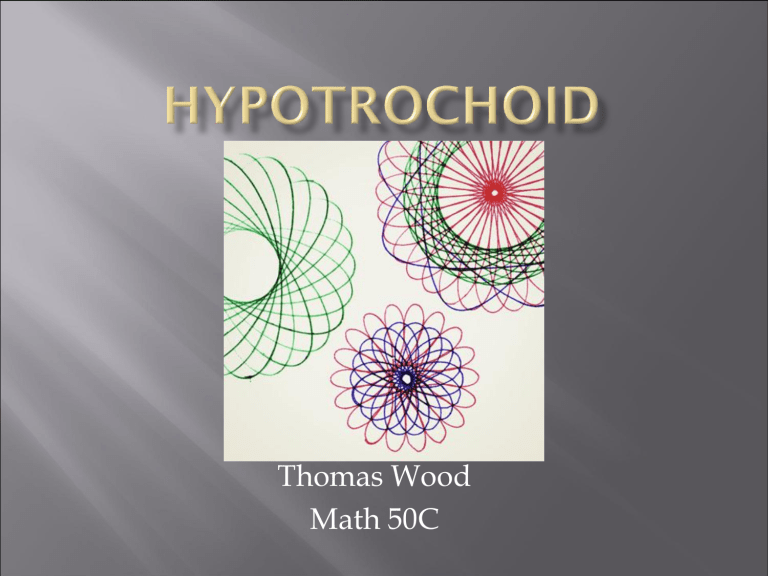Hypotrochoid

Thomas Wood
Math 50C
- A curve traced by a point P fixed to a circle with radius r rolling along the inside of a larger, stationary circle with radius R at a constant rate without slipping.
-The name hypotrochoid comes from the Greek word hypo, which means under, and the Latin word trochus, which means hoop.
.
P
Sir Isaac Newton – English Mathematician
(1643-1727)
Philippe de la Hire – French Mathematician
(1640-1718)
Girard Resargues – French Mathematician
(1591-1661)
Gottfried Wilhelm von Liebniz – German
(1646-1716) Mathematician
Wankel Rotary Engine
Spirograph
First I found equations for the center of the small circle as it makes its motion around the inside of the large circle.
I found that the center point C of the small circle traces out a circle as it rolls along the inside of the circumference of the large circle.
As the point C travels through an angle theta, its x-coordinate is defined as (Rcos ϴ - rcosϴ) and its ycoordinate is defined as (Rsin ϴ - rsinϴ) . The radius of the circle created by the center point is (R-r).
The more difficult part is to find equations for a point P around the center.
As the small circle goes in a circular path from zero to 2 π , it travels in a counter-clockwise path around the inside of the large circle. However, the point P on the small circle rotates in a clockwise path around the center point.
As the center rotates through an angle theta, the point P rotates through an angle phi in the opposite direction.
The point P travels in a circular path about the center of the small circle and therefore has the parametric equations of a circle.
However, since phi goes clockwise, x=dcos ϕ and y=-dsin ϕ .
Inner circle
Adding these equations to the equations for the center of the inner circle gives the parametric equations x=Rcos ϴ-rcosϴ +dcos ϕ y=Rsin ϴ-rsinϴ-dsin ϕ for a hypotrochoid.
Get phi in terms of theta
Since the inner circle rolls along the inside of the stationary circle without slipping, the arc length r ϕ must be equal to the arc length R ϴ.
r ϕ=R ϴ ϕ=R ϴ/r
However, since the point P rotates about the circle traced by the center of the small circle, which has radius (R-r), ϕ is equal to (R-r) ϴ r
Therefore, the equations for a hypotrochoid are x
R cos
r cos
d cos(
R r
r
) y
R sin
r sin
d sin(
R
r
) r
2
1
0
-1
5
4
3
-2
-3
-4
-5
-6
Properties and Special Cases
When r=(R-1), the hypotrochoid draws R loops and has to go from 0 to 2 π*r radians to complete the curve. As d increases, the size of the loop decreases. If d ≥ r , there are no longer loops, they become points.
For example,
R=13, r=12, d=5
R=6, r=5, d=5
5
4
3
2
1
0
-1
-2
-3
-4
-5
-6 -4 -2 0 x-axis
2 4 6 -4 -2 0 x-axis
2 4 6
0
-1
-2
-3
-4
4
3
2
1
If d=r, the point P is on the circumference of the inner circle and this is a special case of the hypotrochoid called the hypocycloid. For a hypocycloid, if r (which is equal to d) and R are not both even or both odd and R is not divisible by r, the hypocycloid traces a star with R points.
R=5, r=2, d=2 R=20, r=7, d=7
15
10
5
-10
-15
0
-5
-4 -2 0 x-axis
2 4 6 -25 -20 -15 -10 -5 0 x-axis
5 10 15 20 25
R=12, r=6, d=3
6
4
2
0
-2
-4
-6
-8 -6 -4 -2
R=2r
0 x-axis
2 4 6 8
R=5, r=7, d=2
3
2
1
0
-1
-2
-3
-4 -3 -2 r>R
-1 0 x-axis
1 2 3 4 5
Butler, Bill. “Hypotrochoid.” Durango Bill’s Epitrochoids and Hypotrochoids.
26 Nov, 2008. <http://www.durangobill.com/Trochoids.html>.
“Hypotrochoid.” 1997. 6 Dec, 2008. <http://www-history.mcs.standrews.ac.uk/history/Curves/Hypotrochoid.html>.
“Spirograph.” Wikipedia. 2008. 7 Dec, 2008.
<http://en.wikipedia.org/wiki/Spirograph>.
Wassenaar, Jan. “Hypotrochoid.” 2dcurves.com. 2005. 6 Dec, 2008.
<http://www.2dcurves.com/roulette/rouletteh.html#hypotrochoid>
Weisstein, Eric W. "Hypotrochoid." MathWorld--A Wolfram Web Resource.
2008. Wolfram Research, Inc. 26 Nov, 2008.
<http://mathworld.wolfram.com/Hypotrochoid.html>.









